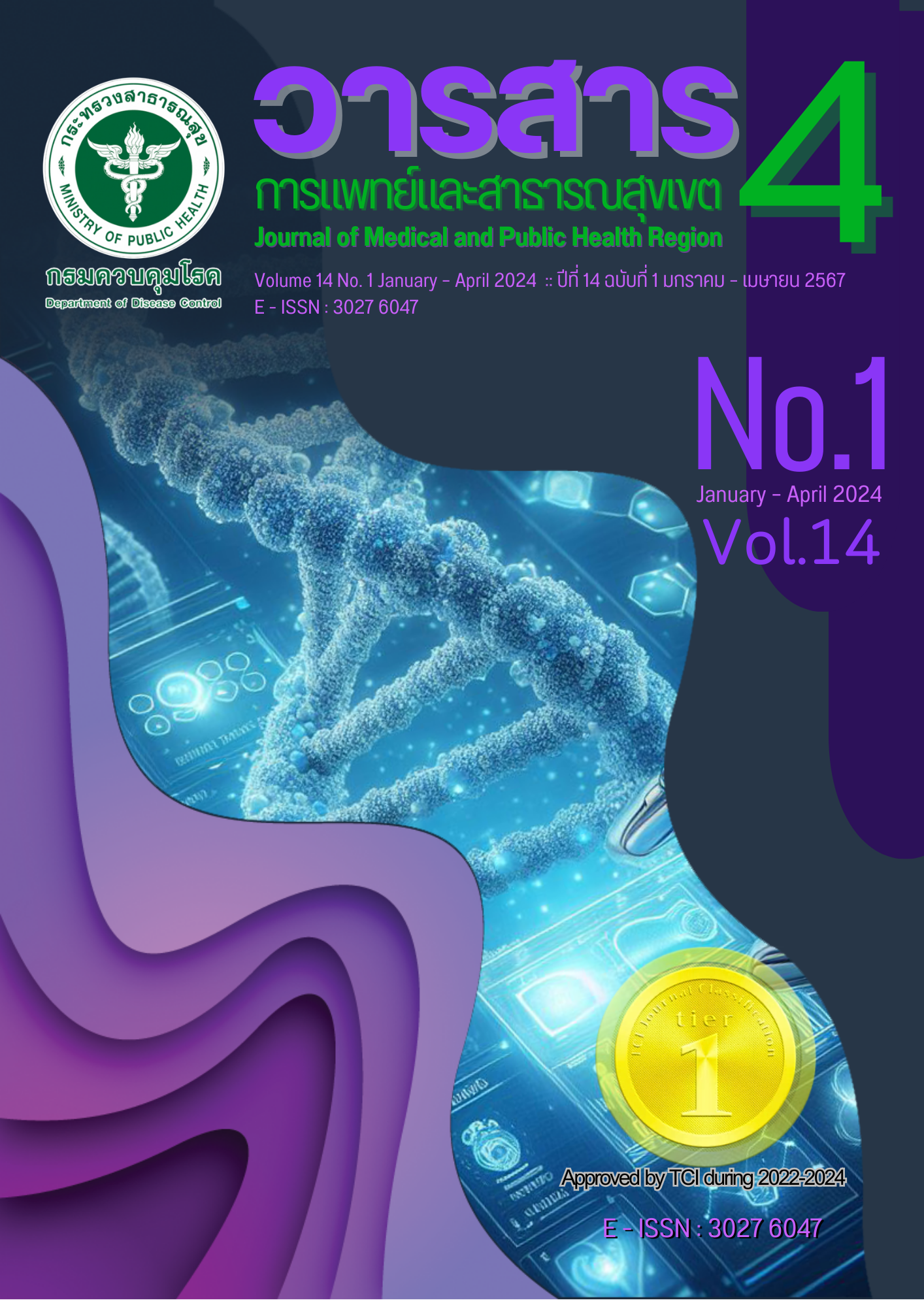การศึกษาความสัมพันธ์ของการวางแผนการดูแลล่วงหน้ากับการได้รับการดูแลจริงในวาระสุดท้าย ในผู้ป่วยที่ได้รับการดูแลแบบประคับประคอง โรงพยาบาลปทุมธานี
Main Article Content
บทคัดย่อ
การวิจัยครั้งนี้เป็นการศึกษาแบบจากเหตุไปหาผลแบบย้อนหลัง มีวัตถุประสงค์เพื่อศึกษาความต้องการและผลลัพธ์ของการวางแผนดูล่วงหน้าของผู้ป่วยที่ได้รับการดูแลแบบประคับประคอง โดยการเก็บข้อมูลย้อนหลังจากการศึกษาเวชระเบียนเกี่ยวกับความต้องการวางแผนดูแลล่วงหน้าของผู้ป่วยและผลลัพธ์ที่เกิดขึ้นจริงของผู้ป่วยที่มารับการรักษาที่คลินิกประคับประคอง โรงพยาบาลปทุมธานีในปี พ.ศ. 2565 วิเคราะห์ข้อมูลด้วยสถิติ ค่าเฉลี่ย ส่วนเบี่ยงเบนมาตรฐาน ร้อยละ และ chi-square ที่ P-value < 0.05 ผลการศึกษาพบว่ากลุ่มตัวอย่าง 226 คน ส่วนใหญ่มีความสามารถในการดูแลตัวเองของผู้ป่วย (PPS) ส่วนใหญ่อยู่ในช่วง 10 - 30 เป็นผู้ป่วยที่เป็นโรคมะเร็งระยะสุดท้ายร้อยละ 90.71 มีการวางแผนการดูแลล่วงหน้า ร้อยละ 92.47 ประเด็นการวางแผนการดูแลล่วงหน้าพบว่าผู้ป่วยได้รับการดูแลจริงตรงตามความต้องการที่บันทึกไว้ในประเด็นการยกเว้นใส่ท่อช่วยหายใจคิดเป็นร้อยละ 98.08 ด้านการยกเว้นการกดนวดหัวใจเพื่อยื้อชีวิตคิดเป็นร้อยละ 99.06 และด้านสถานที่เสียชีวิตคิดเป็นร้อยละ 87.21 การเพิ่มความรับรู้ในภาคประชาชนควรมีหน่วยงานที่มีส่วนเกี่ยวข้อง เช่น สำนักงานคณะกรรมการสุขภาพแห่งชาติ หรือกระทรวงสาธารณสุขควรประชาสัมพันธ์ผ่านสื่อต่าง ๆ เพื่อเพิ่มการรับรู้เรื่องการวางแผน
การดูแลล่วงหน้า ก่อให้เกิดการวางแผนการดูแลล่วงหน้าร่วมกันระหว่างผู้ป่วย ครอบครัวและทีมผู้ดูแล และยังช่วยลดการให้การรักษาที่ไม่ก่อเกิดประโยชน์และไม่สอดคล้องกับความต้องการของผู้ป่วย
Article Details

อนุญาตภายใต้เงื่อนไข Creative Commons Attribution-NonCommercial-NoDerivatives 4.0 International License.
เอกสารอ้างอิง
Booncharoen T. New trends in health technology. Journal of Science and Technology 2013; 6(2): 25-32.
Harutha C, Leelawong S, Atthachaiwat A, Suwonkesawong S. Palliative nursing service system. Nonthaburi. Suetawan; 2016. (in Thai)
World Health Organization. Palliative care [Internet]. 2020 [cited 2023 July 4]. Available from http://www.who.int/mediacentre/factsheets/fs402/en/(Footnotes)12. (in Thai)
Public Health Statistics A.D. 2021. [cited 2023 July 8]. Available from: https://dmsic.moph.go.th/index/ detail/9127. (in Thai)
Ministry of Public Health, Department of Medical Services. Guidelines for caring terminal ill patient. Bangkok. Ministry of Public Health; 2017. (in Thai)
Tipkanjanaraykha K, Saleekul S, Apisitwasana N, Thiammok M. Advanced Care Planning for Peaceful Death. Journal of Boromarajonani College of Nursing 2017; 33(3): 138-45. (in Thai)
Pokpalagon P. Palliative Care model in Thailand. Nursing Journal of the Ministry of Public Health 2017; 26(3): 40-51. (in Thai)
Rajavithi Hospital. Guideline for palliative and end of life care. Bangkok. Rajavithi Hospital; 2021. (in Thai)
Acheepan C, Tangcharoensathien V, Prakongsai P, Wasvit J, Hintamai A, Tiampaiwan A. Survey of Healthcare Access and Health Expenditure of the Deceased Patients 2005-2006. International Health Policy Program; 2007. (in Thai)
National Board of Health. Palliative care for terminally ill patients. Nonthaburi. Pimdee publishing; 2013. (in Thai)
Dhirarotwit S. The exercise of the refuse treatment right of the terminally-ill patient under the national health laws: A comparative study of Thailand and Taiwan. Ramkhamhaeng Law Journal 2022; 11(1): 3-29. (in Thai)
Chiang Mai University, Faculty of Medicine, Department of Family Medicine. Guidelines for making a letter of intent not to receive public health services solely to prolong death at the end of life or to end suffering from illness (Living will). (2nd ed.) Chiang Mai: Department of Family Medicine, Faculty of Medicine, Chiang Mai University; 2019. (in Thai)
Rotpenpian P. Advance Care Planning in the Palliative Patients. Srinagarind Medical Journal 2021; 36(6): 755-60. (in Thai)
Stiel S, Heckel M, Seifert A, Frauendorf T, Hanke RM, Ostgathe C. Comparison of terminally ill cancer-vs. non-cancer patients in specialized palliative home care in Germany-A single service analysis. BMC Palliative Care 2015; 14(1):1–7.
National Cancer Institute. National Cancer Control Program. Bangkok. The Printing Office Agency to assist veterans in Royal Shu patham; 2018. (in Thai)
Satsin T, Matchim Y. End-of-life care: The context of the emergency room. Vajira Nursing Journal 2017; 19(1): 1-9. (in Thai)
National Cancer Institute, Department of Medical Services. National Cancer Prevention and Control Plan. Bangkok. The Printing Office Agency to assist veterans in Royal Shu patham; 2019. (in Thai)
National End of Life care Program. Capacity, care planning and advance care planning in life limiting illness. Leicester: United Kingdom; 2011.
Sritharathikun P, Nethipoomkun S. Impact of advance care planning on the end-of-life care in Maesot Palliative Care Clinic, Tak Province, Thailand. Journal of Primary Care and Family Medicine 2021; 4(1): 97-111. (in Thai)
Rotpenpian P, Bunnug P, Tengrunsun S. Knowledge, experiences and barriers in advance care plan for terminal cancer patients of family medicine residents. Srinagarind Medical Journal 2021; 36(4): 460-8. (in Thai)
Boonyoung S, Wisai K. Palliative Outcome Score, Stress and Depression of the Caregiver safety Implemented Home-Based Palliative Care Guideline among Terminally Ill Patients of Primary Care Network, Phrao District, Chiang Mai Province. Lanna Public Health Journal 2020; 16(2): 104-17. (in Thai)
Boonmorakot p. Chunuan S. Palliative care to cancer patients: The effects of a systematic advance care planning on the refusal of end of life-sustaining. The Southern College Network Journal of Nursing and Public Health 2022; 9(1): 270-82. (in Thai)


